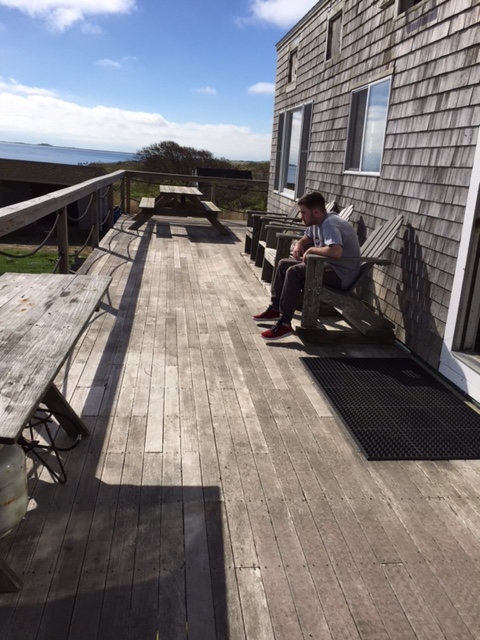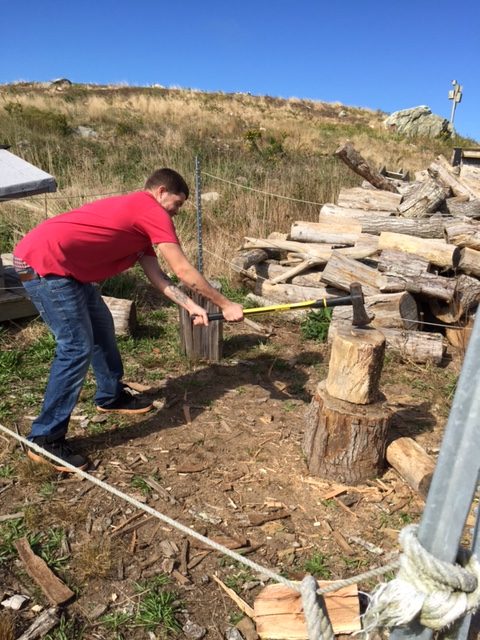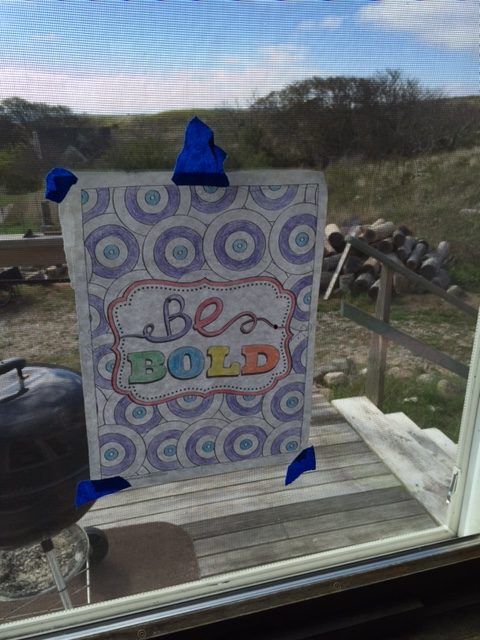About a dozen miles off the coast of Cape Cod sits a rustic island named Penikese — part of the Elizabeth island chain. A hundred years ago, Penikese was home to a leper colony, then a school for troubled boys and a bird sanctuary. This past fall, Penikese opened to its newest incarnation — a treatment program for opioid addicts.
We leave the dock in Woods Hole on a 35-foot lobster boat, and push off into the calm waters of Buzzards Bay. An overcast dawn has made way for blue skies and stunning visibility. We can see seals on the rocks in the distance.
It’s my first time on this hour-long trip, but for the staff of the Penikese Island treatment program, this is their commute. Clinical director Coco Wellington, a rugged, straight-talking woman, says it never gets old.
“I’m in love with that island,” she says, as the land comes into view. “It’s so starkly beautiful.”

As we pull in, three young men walk down a hill from an 1840s style farmhouse to help bring up groceries and prescription medicine from the mainland. They greet the staff as they get off the boat.
Not long ago, these men were in jail, and before that, using or selling heroin. All three asked to be identified by first name only — Kevin, Tracy, and Brett. None of them have been here longer than a week.
“How you doing?” Wellington asks. “How did you guys sleep last night?”
“Like I was in hibernation,” Kevin replies.

As we walk up the hill, a few small buildings and woodpiles dot the landscape, but mostly it’s barren grassland, with sandy inlets and windswept shrubbery.
This 75-acre island has an exotic history. The Wampanoag Indians lived here until the English arrived. A few centuries later, it housed a marine laboratory.
In the early 1900s, the state of Massachusetts bought Penikese for a leper colony — its isolation ideal to hide away that era’s medical pariahs.
“When the leper colony closed, they burned all the buildings,” says oceanographer Jim Newman, chair emeritus of the board that oversees Penikese Island. “It’s not clear anybody wanted it for a while there.”

The island stood virtually empty until the 1970s, when a former Marine opened a school and boot camp for troubled boys. But after 40 years, enrollment declined and the school closed. That was 2011, just as the opioid epidemic in New England was taking hold.
The board looked for an agency to turn it into an addiction treatment program for young men. One venture closed after a few months. They eventually found the Children’s Study Home, a social service agency based in Springfield.
After negotiating for a year with the Department of Public Health for a license, they brought their first patient out to the island in August.

Penikese is billed as a re-creation of 19th century life. The only electricity is solar-powered — just enough for the staff to charge their phones, run the fridge, and keep one laptop functional. There is Wi-Fi and a landline, but no TV, no iPods, no electric light.
Tracy is a 24-year-old New York City native who used to go to clubs every night. Now, he passes the morning learning how to play backgammon from nurse Stephanie Schmidt.
“So if I get a one, I can get you out,” she explains, as Tracy rolls the dice. “Double ones — yee-haw.”

The men went through detox before coming to the island; this is the therapeutic stage. They’ve been screened for suicidal and violent histories. The treatment philosophy revolves around delayed gratification — any delivery is a day away — and the island itself is a therapeutic partner.
“Penikese Island has one attribute that very few other places have — and that is, isolation,” says island caretaker Weston Lant, a former rock band roadie turned organic farmer.
Lant says the addiction program here is unlike even the best urban clinic, where in a moment of weakness, “you could walk out the door and drop a dime and get what you need, or what you think you need. Here, that’s off the table. and that’s as much a security issue as it is, security for them. It’s freedom, like, you don’t have to think about i, it’s not gonna happen here. So now you can think about everything else. Now you can focus.”
But these men didn’t exactly seek out the place for its therapeutic qualities. All had been convicted on drug charges and given the choice of incarceration or treatment.
“This place got me in quicker,” says Kevin, 20. “It was like, you can go here in two days or you can wait in jail for another month and a half, two months, to get somewhere else.”

Kevin is quietest of the three patients. For part of the day, he sits alone on the front porch, looking out at the bay, and sometimes at his own feet. He’s still adjusting.
“I came from jail, so everything’s like loud, and everyone’s just crazy,” Kevin says, “and you come here, and it’s just — dead silent. All the time.”
Is that good or bad? “It’s just shocking. More time to think. Just sit there and thinking.”
Another patient, Brett, 26, has already tried and failed at a more institutional rehab. He says he’s open to the island’s healing properties, but still getting used to kerosene lanterns, going to bed at 9, cooking on a cast-iron stove.
“You’ve got to heat the stove by burning the wood, multiple hours before you’re trying to cook,” he says.

Not only that, but they have to chop the wood themselves.
This is their first day of training on using an ax.
“You want to eat? You’ve got to cut wood,” says Lant, as Kevin takes a swing.
“Looks like I’m going to starve,” Kevin responds with a laugh, before getting in a few successful chops.

This is also part of the treatment curriculum — physical exertion with a meditative undercurrent.
‘The confinement is more in your mind,” says Lant. “In other words, you’re not in a rehab center. You’re on an island. And you’re not locked away while everyone else is conducting their life. You’re conducting your life here.”

There’s room on the island for 12 patients, but the agency hasn’t been able to hire enough staff for a full house. It’s been hard to find and keep people willing to commute an hour by powerboat and leave their home for three-day shifts. The remaining therapists work to create a sense of family with the patients — the kind born of mutual dependency.
Everyone cooks, eats and cleans together, and as they do, therapy happens incidentally. Tracy hovers over a charcoal grill, having just finished a Skype meeting upstairs with an off-site psychiatrist. He tells counselor Nick Bellomo that the doctor diagnosed him with PTSD.
“How’d it go?” Bellomo asks.
“It made me feel like I was crazy,” Tracy says.
As the burgers cook, Tracy tells Bellomo the doctor wants him to go on a new psychiatric medication, and Bellomo suggests he do some research on the drug.
“Google is amazing,” Bellomo says, to which Tracy replies, “OK, but we’re on an island where we cannot have electronics.”
That seems like a fair point, though Bellomo offers to print the information on his day off. Tracy shrugs, and asks Brett to take over the grill.
“I just burnt all the hair off my knuckles,” Tracy says, as Brett grabs a pair of tongs.

Judging from the good moods and mild weather, this seems like an ideal day on the island. But as the days get shorter, Brett expects life will get harder.
“It’s going to get cold here real soon, and the winters aren’t very fun on Cape, so I can’t imagine being on an island that’s not very big,” Brett says. “Snow, the wind. Nothing to block the wind out.”
And at one point, Brett whispers into my microphone the audio equivalent of a message in a bottle.
“Take me back,” he says with a laugh. “Help! help!”
He’s joking of course (well, half-joking) but ultimately, Wellington — the clinical director — says how the men react to the island’s challenges over time will let staff know when they’re ready to leave. It could be 30 days, 90 days or longer.
“Are they going to turn to staff and ask for help? That tells you something,” she says. “Or are they just going to dissolve in a bundle? Or are they going to run away? All of those things tell us how they manage stress.”
The last official activity of the day is group therapy in the island’s one-room schoolhouse. Wellington starts the session with a Tibetan bowl ringing and moves into a mindfulness exercise with M&M’s.
“I want you to put it in your mouth, but do not chew it,” she tells them. “Just feel it with your tongue, feel the taste, the texture.”
She then leads them into talking about addiction.
“When you get upset, what are the triggers and how do you react to them?” Wellington asks.
And then it’s their turn to weigh in on the rules of the island. Brett goes first.
“Why are there no MP3 players allowed? Like the ones that have no screens,” he says.
“We want people to unplug; we don’t want them to tune out,” Wellington replies. “That’s really important to this whole process.”
Wellington adds they don’t have enough electricity to keep devices charged — and anyway, no one in the 1800s had MP3 players. But the men aren’t buying it.
“It’s like, the whole quitting every substance, all the alcohol, cigarettes, everything at once,” Brett says. “Getting to make a phone call, but being told you can only call once every however often. It’s very difficult. Same thing with not listening to music, not being able to keep tabs on my favorite football team.”
The counselors decide one rule they can relax is supervision. Patients are free to roam the island alone. They can check out a bird sanctuary for arctic terns on the other side of the island, or visit the leper graveyard from the 1920s.

Tracy admits he’s already been exploring the shore.
“This morning I was just lost in my own head,” he says. “I was starting to walk to the basketball court and next thing I know, I was at the dock. I was like, ‘Oh.'”
These guys will settle into island life and start to face their demons, Wellington tells me later. It just takes time — something they have here in great supply. For now, they’re still getting to know each other, a task made easier by their low-tech entertainment options, like the ping pong table that Kevin and Brett discover.
“Stop showing me up!” Brett says with a laugh as he takes a shot.
In the long run, for this program to work, the Children’s Study Home has some challenges ahead.
According to the director, treatment costs $500 per day per client. They’re not yet licensed to take insurance, and they don’t want it become a country-club clinic for the rich, so right now it’s mostly funded by donations.
Sadly, they don’t expect the demand for opioid treatment to drop off anytime soon. If this approach succeeds, they hope to be a model for the rest of the country — at least, wherever there’s a free island.

